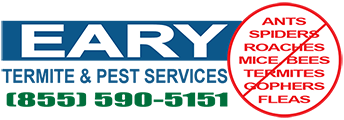
03 Aug FAQs About California Termites
How much do you really know about termites? You’ve heard these common household pests damage and destroy wood. But what other facts can help you to better understand (and treat) an infestation? If termites have turned your home into theirs, take a look at the top questions about these pests answered.
What Are Termites?
Termites are often confused with ants — especially carpenter ants. While both pests enjoy wood, only termites eat tree stumps, blanks, beams, and other wooden items. Even though termites may look like and sometimes act like ants, these pests are a different species of insect. Along with a love of wood, both termites and carpenter ants may have wings and can swarm. But that’s where the similarities end.
In general, the termite has a broad waist (carpenter ants have narrow or pinched waists) and a long body. But some types of termites may not look like what you’d expect — especially the alien-like conehead termite.
What Types of Termites Are Common in California?
There are more than 2,600 termites species found across the globe, according to the University of California. The most common types of termites across the country include subterranean, Formosan, dampwood, and drywood species. California is home to at least 23 types of species, including these termite types.
Even though there are almost two dozen types of termites active in California, the top problematic pests are the subterranean and drywood species.
Do Termites Have a Social Structure?
Ants and bees aren’t the only problematic pests with a serious social structure. Termites also live in colonies made up of different castes. Each colony can have anywhere from a few mated pairs to millions of members. Most colonies include young or immature larvae, nymphs, soldiers, workers, and reproductive termites. Each caste looks and acts differently. The specific types of termites or castes a colony has depends on the size of the group and the species.
The different appearances between castes can make it difficult for a termite novice to accurately identify the pest. Misidentification can result in the wrong type of treatment plan. This can leave your home with a continuous termite problem and serious structural (or other) damage.
Do Termites Seriously Damage Homes?
Simply stated — yes. Termites cause a collective five billion dollars in property-related damage annually in the U.S. While termites often use outdoor wood sources (such as tree stumps) as a cellulose food source, the pest will also eat your home’s interior structure. This includes structural support beams, flooring, and more.
Can You Treat a Termite Infestation?
You think your home has a termite colony. What should you do next? Again, correct identification is essential. This means you need to hire a professional pest control contractor and schedule an inspection as soon as possible. Not only will the professional know what to look for — they’ll know where to look.
Unlike ants and other common household pests, termites are rarely seen out in the open. The pest control pro can find colonies in walls, underground, or in other similar spaces.
After the exterminator finds the source of the problem, they can walk you through the next steps. The treatment may include either a localized spot treatment or a whole-home option. If you’re not sure where the colony is or if your home has several nests, a whole-home approach is the best way to potentially eliminate the entire infestation. A spot treatment could leave some termites behind, opening your home up to a re-infestation.
Do you need help to control a termite infestation problem? Contact Eary Termite & Pest Services for more information.




Sorry, the comment form is closed at this time.